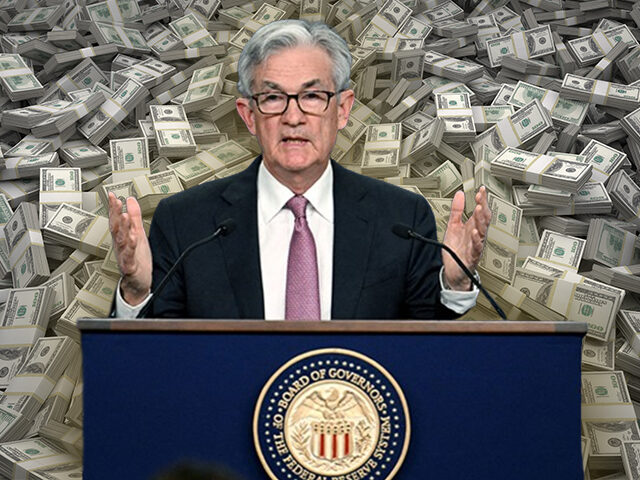Fed Policy Isn’t Holding Back Home Builders
It’s getting harder each day to avoid the conclusion that the Federal Reserve’s supposedly tight leash on the economy might be more of a myth than a reality.
Consider the latest dispatch from the housing sector: On Tuesday, the bean counters told us that ground was broken on new homes at an annual clip of 1.512 million in February. That’s not just a brisk pace. It’s a veritable sprint, signaling that this cylinder of the engine of American growth isn’t just chugging along—it’s racing.
As the chart below illustrates, housing starts are very elevated by historical standards.

The surge in homebuilding traces its lineage to the notable migration of this decade, the retreat from the urban hustle of the pandemic‘s enforced seclusion, the newfound liberty of remote work, and the urban upheavals following the 2020 Black Lives Matter protests and riots.
Housing starts have remained buoyant, an artifact of the prevailing interest rates’ ascent above the tether of prior mortgages, rendering many a homeowner stationary. For many owners, it is better to sit put than to sell their home and buy a new one with a much higher interest rate.
The resonance of this situation with the broader economy is profound. Housing usually dances closely with interest rates, their tango typically a delicate balance where the rhythm of rates guides the pace of building. Yet here we are, witnessing an unusual choreography. Instead of quieting the construction clamor, high rates have instead lent it a new cadence.
The act of raising homes from the earth is no minor affair; it is an endeavor that courses through the economy with substantial gravitas. It employs swathes of labor, devours materials, and each new dwelling beckons for furnishings, appliances, perhaps even a car in the driveway. New homes require energy to heat them and keep the lights on, driving up demand for utilities and putting inflationary pressures on fuel prices. A new home, in other words, triggers a cascade of economic multiplier effects.

(iStock/Getty Images)
There likely is a rate that would temper this exuberance. We just have not yet discovered it. It may be that rates need to be rising to quell housing demand, as the populace acclimates to the prevailing financial winds so that what was restrictive at one point soon loses its gravity. What’s more, the promise of lower rates is likely encouraging homebuyers. As we discuss below, the future’s whispered promises of lower rates entice buyers to embrace today’s steeper mortgages, envisaging a refinancing renaissance ahead.
Our housing markets, much like our labor markets, seem to articulate a similar doctrine: the gauge of restrictiveness in interest rates demands recalibration. The “neutral rate”—the economists’ term for the equilibrium point where growth is neither spurred nor stymied—looms higher than the 2.5 percent the Fed has remained anchored to since 2019. To put it differently, the real neutral rate—the neutral rate after inflation, known as r-star—is likely higher than the 0.5 percent the Fed’s projections assume.
Which leads to the inevitable inquiry: what currents have lifted this neutral rate to its newfound altitude?
The End of Secular Stagnation
We were always skeptical of the claim that the U.S. had entered a period of “secular stagnation.“ This seemed to be a diagnosis based on the failure of the Obama administration’s policies to restore growth rather than a deep insight into the economy. It wasn’t that the snake oil was not working, it’s just that the malady was incurable.
The return of economic vigor when the Obama years came to a close and brought the promise of relief from Obamanomics confirmed that impression. Further confirmation came from the almost unheralded (Breitbart News being the rare beacon of the burgeoning Trump boom) economic progress of the Trump years. The dream of economic liberty and prosperity was returning—and this was becoming a self-fulfilling prophecy.
Then there is the renewed health of the balance sheets of the private sector. After the financial cataclysm of the late aughts, American households, chastened and over-leveraged, embarked on a decade-long Odyssey of deleveraging, a saga of thrift that undoubtedly dampened the fires of demand. This deleveraging process was accelerated by the pandemic-era policies that effectively transferred debt from the private sector and local governments to the federal government.
Unfortunately, the Biden administration decided from the start that it would not accept the fact that the economy was recovering in the second half of 2020. Biden had lofted himself into the White House complaining, contrary to all evidence, that his predecessor’s policies had pushed the economy into the abyss. So when Biden took office, his advisors foisted upon the country the fiscally reckless American Rescue Plan, pouring fuel onto the inflationary pyre of clogged supply chains, shifting consumer preferences, and “revenge” spending of demand pent-up during lockdowns.
The fiscal impulse has been maintained throughout the Biden administration, with deficits running at crisis levels despite extremely low unemployment. This too is very likely elevating the North Star of neutral interest rates.
Simultaneously, the siren song of globalization, which once lured capital to distant shores, has been drowned out by the chorus of economic nationalism. The clarion call now is for resilience, for the fortification of supply chains closer to home and a revival of domestic industrial employment, a trend that invariably invites capital to return to domestic hearths and Americans to return to the manufacturing forges, thus buoying our elusive neutral rate. Despite the hand-wringing worries about lost efficiency from the globalists, economic nationalism appears to be boosting U.S. productivity.
The new tune is inspiring more confidence in workers. While the post-financial crisis years were characterized by economic precarity, with workers afraid to lose scarce jobs, the post-pandemic period has seen employers “hoarding” workers and workers more confident that they can hang on to their jobs until they choose to move on. Moving from job precarity to security is likely one of the reasons household spending has been so surprisingly resilient.
Not to be overlooked is the technological renaissance, a pivot from the ethereal realms of software to the more corporeal domain of hardware, spurred by exigencies of national security and the vanguard of AI. This shift from the digital to the tangible, epitomized perhaps by the renaissance of firms like Nvidia, speaks to a burgeoning capital intensity that heralds, yes, an elevation of our celestial neutral.

The Nvidia office building in Santa Clara, California, on May 31, 2023. (AP Photo/Jeff Chiu)
Yet the drama does not end here. For amidst the pandemonium of a global pandemic, households and corporations locked in low-interest rates, a bulwark against the tempestuous seas of monetary policy. Thus insulated, they gaze upon the Fed’s machinations with a bemused detachment, their financial fates partially decoupled from the whims of interest rate policy.
What’s more, the Fed’s insistence that the long-run rate is lower than current rates boosts activity and undermines the effectiveness of higher interest rates. Businesses calculating the return hurdles needed for new investments do not use current financing rates but the expected rate over time. Homebuyers, as we indicated above, are willing to accept higher rates because they plan to refinance later. If inflation is falling, pushing up the real rate, they only expect that means the nominal rate will fall faster.
What this means is that the increase in the real rate does not necessarily make financial conditions more restrictive. If it is driven by a decline in inflation, then the rise of real rates might actually loosen financial conditions by moving forward expectations of rate cuts.
The Most Important Rate Is Not on The Table…Yet
The Federal Reserve began its two-day policy meeting on Tuesday. While the Fed has made it clear it will not be adjusting its policy rate at the end of the meeting on Wednesday, participants at the meeting may adjust their projections for the year. It’s very likely that the median projected growth rate and the median projected inflation rate will be higher.
The big question is what happens to the Fed’s federal funds projection. In the December Summary of Economic Projections, the median forecast was for 75 basis points of cuts this year. That looks increasingly unlikely. We expect that the median will drop down to 50 basis points, although there’s a risk that officials will shy away from pulling back on cuts for fear of spooking markets and enraging Democrats pushing for immediate cuts.
What the Fed should do is raise the projected longer run fed funds rate, its stand-in for the neutral rate. That’s not in the cards this week, but we think that the Fed will likely have to come to terms with the higher r-star at some point or surrender its dedication to holding inflation down to two percent a year.

COMMENTS
Please let us know if you're having issues with commenting.